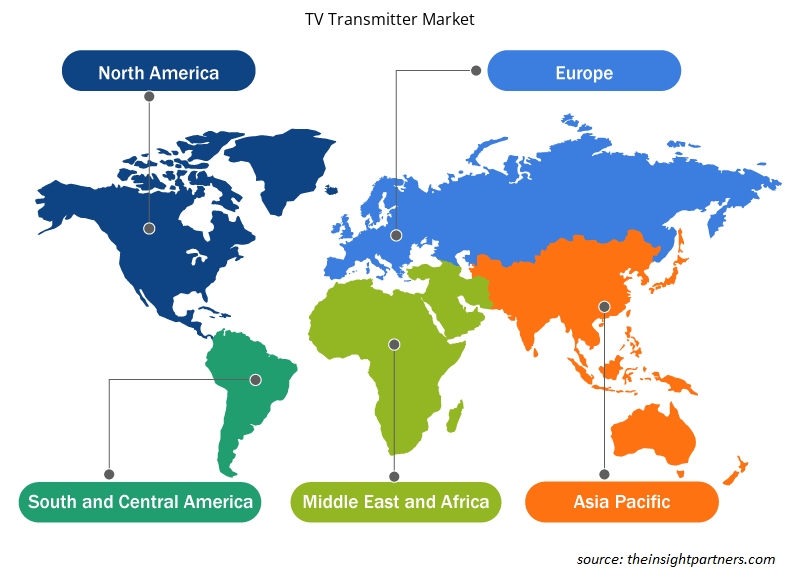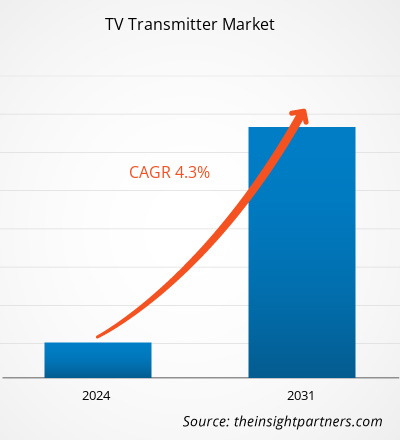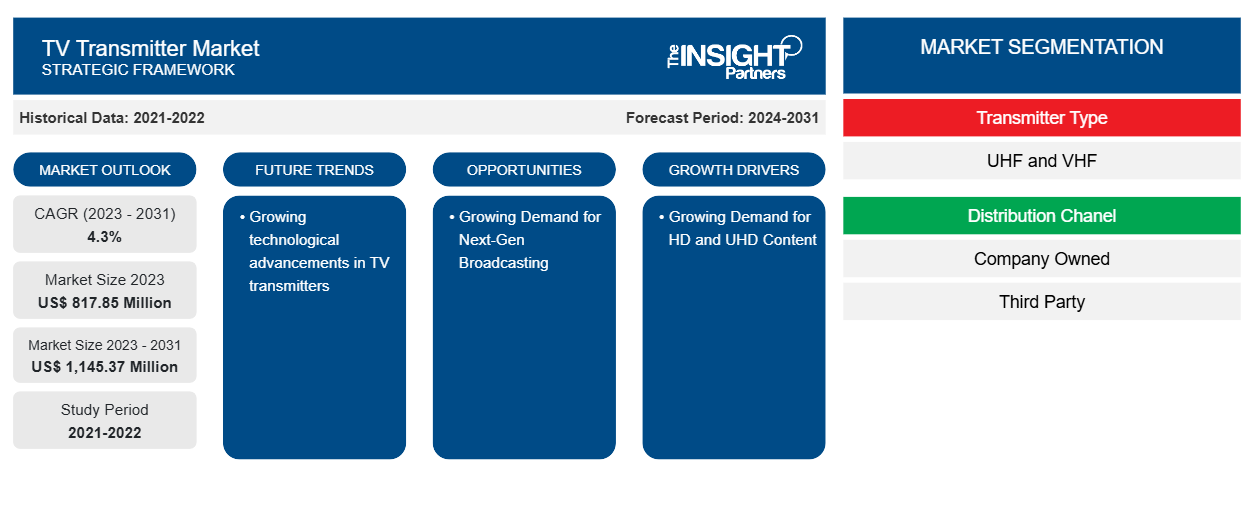电视发射机市场规模预计将从 2023 年的 8.1785 亿美元增至 2031 年的 11.4537 亿美元。预计 2023-2031 年市场复合年增长率为 4.3%。对高清内容的需求不断增长可能仍是电视发射机市场的一个关键趋势。
电视发射机市场分析
全球对高清和超高清内容的需求不断增长是推动电视发射机市场增长的主要因素之一。此外,电信和广播领域的不断创新正在推动电视发射机市场的增长。此外,对下一代广播的不断增长的需求预计将在预测期内推动市场的增长。此外,电视发射机技术的不断进步为未来几年电视发射机市场的增长创造了机会。
电视发射机市场概况
电视发射机是一种电子设备,它发射无线电波,携带显示动态图像的视频信号和与之同步的音频信号。它将被电视接收器接收,电视接收器将在屏幕上显示图像并播放匹配的声音。其工作频率仅限于 VHF 和 UHF 频段,其功率输出范围为 5W 至 10kW。它通常用于电视广播领域,例如电视台。
定制此报告以满足您的需求
您可以免费定制任何报告,包括本报告的部分内容、国家级分析、Excel 数据包,以及为初创企业和大学提供优惠和折扣
-
获取此报告的关键市场趋势。这个免费样品将包括数据分析,从市场趋势到估计和预测。
电视发射机市场驱动因素和机遇
对高清和超高清内容的需求不断增长
全球消费者对高清 (HD) 和超高清 (UHD) 内容的需求正在增加,特别是因为它提供了更高质量的音频和视频。此外,随着高质量内容的发布,全球 OTT 平台的使用也在增加。因此,对高质量内容的需求不断增长,推动了电视发射机市场的增长。
生长对下一代广播的需求
下一代广播包括采用数字广播标准,世界各地的不同地区采用特定标准,如美国的 ATSC 3.0、欧洲的 DVB-T2 和亚洲和南美洲某些地区的 ISDB-Tb。这些标准的好处包括提高音频和视频质量、更有效地利用可用频谱以及增加新的交互功能。向数字广播标准的过渡使传输高清 (HD) 和超高清 (UHD) 节目变得更加容易,这为观众提供了更好的视听体验并增加了他们对电视的享受。因此,对下一代广播的不断增长的需求预计将为电视发射机市场的增长创造机会。
电视发射机市场报告细分分析
有助于得出电视发射机市场分析的关键部分是发射机类型、分销渠道和应用。
- 根据发射机类型,电视发射机市场分为 UHF 和 VHF。UHF 部分在 2023 年占据了更大的市场份额。UHF 部分进一步细分为低、中、高。同样,VHF 部分进一步细分为低和中。
- 根据分销渠道,市场分为公司自有和第三方。2023 年,公司自有部分占据了最大的市场份额。
- 根据应用,市场分为小型电视台和大型电视台。大型电视台在 2023 年占据了最大的市场份额。
电视发射机市场份额按地区分析
电视发射机市场报告的地理范围主要分为五个地区:北美、亚太、欧洲、中东和非洲、南美/南美和中美。
就收入而言,亚太地区占据了电视发射机市场的最大份额。该地区的市场分为澳大利亚、中国、印度、韩国、日本和亚太地区其他地区。该地区的市场参与者不断致力于广播领域的技术进步,这是推动亚太地区电视发射机市场增长的主要因素。此外,该地区的媒体和娱乐行业正在经历巨大的增长,这进一步推动了电视发射机市场的增长。
电视发射机市场区域洞察
Insight Partners 的分析师已详细解释了预测期内影响电视发射机市场的区域趋势和因素。本节还讨论了北美、欧洲、亚太地区、中东和非洲以及南美和中美洲的电视发射机市场细分和地理位置。

- 获取电视发射机市场的区域特定数据
电视发射机市场报告范围
| 报告属性 | 细节 |
|---|---|
| 2023 年的市场规模 | 8.1785亿美元 |
| 2031 年市场规模 | 11.4537亿美元 |
| 全球复合年增长率(2023 - 2031) | 4.3% |
| 史料 | 2021-2022 |
| 预测期 | 2024-2031 |
| 涵盖的领域 |
按发射机类型
|
| 覆盖地区和国家 |
北美
|
| 市场领导者和主要公司简介 |
|
电视发射机市场参与者密度:了解其对业务动态的影响
电视发射机市场正在快速增长,这得益于终端用户需求的不断增长,而这些需求又源于消费者偏好的不断变化、技术进步以及对产品优势的认识不断提高等因素。随着需求的增加,企业正在扩大其产品范围,进行创新以满足消费者的需求,并利用新兴趋势,从而进一步推动市场增长。
市场参与者密度是指在特定市场或行业内运营的企业或公司的分布情况。它表明在给定市场空间中,相对于其规模或总市场价值,有多少竞争对手(市场参与者)存在。
在电视发射机市场运营的主要公司有:
- 罗德与施瓦茨
- 日本电气公司
- 日立国际电气集团
- 商务电子技术服务协会
- 埃盖特
- 盖茨航空
免责声明:上面列出的公司没有按照任何特定顺序排列。

- 获取电视发射机市场顶级关键参与者概览
电视发射机市场新闻和最新发展
通过收集主要和次要研究后的定性和定量数据来评估电视发射机市场,其中包括重要的公司出版物、协会数据和数据库。以下是言语和语言障碍市场的发展和策略列表:
- 领先的媒体交付解决方案提供商 ENENSYS Technologies 和意大利电视发射机制造商 ELECTROLINK 宣布,他们已成功向 Rai Way 交付了在阿布鲁佐、拉齐奥和利古里亚地区运行的所有 DVB-T/T2 发射机系统,这些系统与意大利的重新耕作项目有关,该项目是通过公开招标委托的。ENENSYS 和 ELECTROLINK 为这个项目建立了特殊的合作伙伴关系,每家公司都提供最好的组件和工程服务,以向 Rai Way 提供最高效、最可靠和最先进的 DVB-T/T2 发射机系统。(来源:ENENSYS Technologies,新闻稿,2023 年)
- 菲律宾中央希望频道在菲律宾宿务市中央菲律宾联盟会议 (CPUC) 总部启用了新的演播室和发射站。(来源:基督复临安息日会,新闻稿,2023 年)
电视发射机市场报告覆盖范围和交付成果
“电视发射机市场规模和预测(2021-2031)”报告对以下领域进行了详细的市场分析:
- 范围内所有主要细分市场的全球、区域和国家层面的市场规模和预测
- 市场动态,如驱动因素、限制因素和关键机遇
- 未来的主要趋势
- 详细的 PEST/波特五力分析和 SWOT 分析
- 全球和区域市场分析涵盖关键市场趋势、主要参与者、法规和最新市场发展
- 行业格局和竞争分析,涵盖市场集中度、热点图分析、知名参与者和最新发展
- 详细的公司简介
- 历史分析(2 年)、基准年、预测(7 年)及复合年增长率
- PEST和SWOT分析
- 市场规模、价值/数量 - 全球、区域、国家
- 行业和竞争格局
- Excel 数据集
近期报告
相关报告
客户评价
购买理由
- 明智的决策
- 了解市场动态
- 竞争分析
- 客户洞察
- 市场预测
- 风险规避
- 战略规划
- 投资论证
- 识别新兴市场
- 优化营销策略
- 提升运营效率
- 顺应监管趋势























 获取免费样品 - 电视发射机市场
获取免费样品 - 电视发射机市场